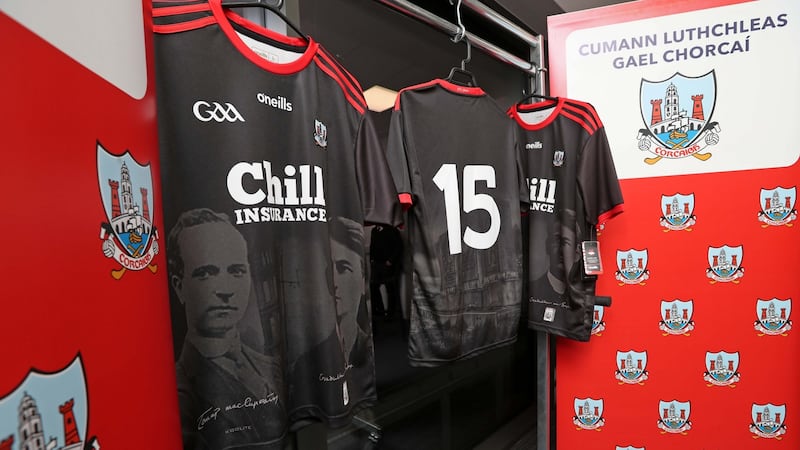This Sunday at Páirc Uí Chaoimh, Cork’s county footballers will do as their hurlers did at the same venue last week. They will forsake the traditional red jersey to become, for one day only, men in black.
The special jersey they will wear, sponsor’s logo intact, was designed to commemorate events of a century ago, and bears the profiles of two martyred lord mayors of Cork, Tomás MacCurtain and Terence MacSwiney, on one side and images of a Kilmichael ambush memorial and a burning Cork city centre on the other.
In a year that has already seen one ill-conceived commemorative enterprise – the Department of Justice’s aborted plan to acknowledge the DMP and RIC – this one has all the appearances of being another.
On this occasion, however, it is not the who or what that is being commemorated that raises questions – that much is straightforward – but how it is that Cork GAA felt that it was its place to lead the commemorating and what, beyond mere revenue raising, it hopes to achieve with it.
That the MacCurtain and MacSwiney families have expressed pride in the jersey is entirely understandable. But what is clear from the publicity accompanying its launch is how little serious thinking lies behind the commemoration or any sense that it might, as Croke Park’s plan for the year does, form part of a deeper, more reflective programme of activity.
All the Cork County Board really revealed was that it had decided to mark the “centenary of a tumultuous 12 months”, and that the new shirt would be available to purchase online and in local shops in the coming weeks – it will set you back a cool €70.
So be it, and no doubt the shirt will sell well for them and for O’Neill’s, but this is hardly the stuff of substantive commemoration, the kind that aspires to something more than a Carroll’s gift shop-style engagement with the past.

Moreover, in wrapping the Cork jersey around a particularly traumatic historical narrative the inescapable impression it has helped create is that of the GAA being somehow intimately associated with the events being commemorated.
It was not, of course.
Brutal reprisals
Cork was indeed at the epicentre of the violence that escalated throughout 1920 as the campaign of republican attacks on RIC barracks intensified (Cork was home to the largest number of police barracks in the country at the time) and British crown forces settled into a pattern of brutal reprisals, targeting property and the civilian population as a response to the IRA’s guerrilla-style tactics.
Writing in his 1940s memoir, JJ Walsh, a modernising Cork GAA County Board chairman-cum-local-Irish-Volunteer founder and Sinn Féin TD, recalled that “without exception, every man from the Rebel County who participated in this epic struggle for liberation was a Gael”.
Walsh certainly saw the GAA as a potential training ground for physical force nationalism, and he was by no means unique in marrying his sporting and political passions – high profile Cork GAA figures such as Seán McCarthy, Tadhg Barry and Pádraig Ó Caoimh were also dual players – but his claim as to the inseparability of GAA membership from the republican movement does not survive contact with a more messy and complicated reality.
For whatever about the separatist struggles of select individuals, the overriding GAA focus remained on the games themselves, the standout feature of the GAA experience of the revolutionary era being its determination to maintain traditions of play amid the disruptions of revolution and in an environment that was, in many ways, hostile and oppressive.
As for MacCurtain and MacSwiney, whatever GAA links they had were hardly character-defining.
It is striking, for instance, that across Patrick Maume’s entries for both men in the mammoth Dictionary of Irish Biography, the GAA merits not a single mention. It was the Gaelic League, not Gaelic games, that influenced most their cultural and political formation.
Allegiances
None of which is to suggest that the GAA was either silent on, or unaffected by, the two men’s deaths. Far from it: when MacSwiney died on the 74th day of his hunger strike in Brixton and his emaciated corpse was returned to Cork, the city of which he was first citizen made clear its allegiances. The streets thronged with people and there was an “unending procession” past MacSwiney’s open coffin when it was laid out in the city’s pro-cathedral.
Not only was the GAA officially represented among the mourners, it cancelled its games as a mark of respect, and the Cork County Board passed a resolution expressing both its sympathies and its “sincere appreciation and admiration of the noble and heroic sacrifice” made by the “late martyred Lord Mayor”.
The board had done something similar following the RIC murder of MacCurtain at his home the previous March.
Yet in responding in the ways it did the GAA in Cork and elsewhere was doing no different to any number of civic society organisations – trade unions and employer federations etc – from whom similar expressions of sympathy and outrage poured forth.
The point of it all is this: the Cork GAA holds no special claim on the events in Cork in 1920, and its relationship with nationalism is more nuanced than this jersey commemoration allows anyone to comprehend.
Ultimately, this commemorative act does little more than ascribe to the GAA a relationship to events that its history hardly merits and in a manner that does little to deepen an understanding of the period.
The GAA’s moment in the commemorative spotlight will, of course, come with the centenary of Bloody Sunday later this year; it might have been better to await its time.
Mark Duncan is a historian of the GAA and director of Century Ireland









